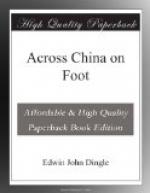In the early days, when different clans were driven farther into the hills, they each clinched as much land as they could. In course of time, by petty quarrels, civil wars, and common feuds, the Nou-su were gradually thinned out. The Miao-tsi—the men of the hills and the serfs of the landlords, who four thousand years ago were a powerful race in their own kingdom—became the tenants of the Nou-su, whose rule is still marked by the grossest infamy possible to be practiced on the human race. All the methods of torture which in the old days were associated with the Chinese are still in vogue, in many cases in an aggravated form. I have personally seen the tortures, and have listened to the stories of the victims, but it would not bear description in print.
It must not, however, be understood that to be a Nou-su is to be a landlord. By no means. For in the gradual process of the survival of the fittest, when the weaker landlords were murdered by their stronger compatriots and their lands seized, only a small percentage of the tribe in this area have been able to hold sway. However, wherever there are landlords in this part of the country, they are always Nou-su or Chinese. The Miao—or, at least, the Hua Miao, own no lands, and are body and soul in the tyrannic clutch of the tyrannic I-pien. Then, again, in the Nou-su tribe there are various hereditary distinctions enabling a man to claim caste advantage. There are the Black Bones, as they style themselves, the aristocrats of the race, and the White Bones, the lower breeds, who obey to the letter their wealthier brethren—or anybody who has authority over them.
The Nou-su, who are a totally different race and a much better class than the Miao, are believed to have been driven from the Chao-t’ong Plain, preferring migration to fighting, and many trekked across the Yangtze (locally called the Kin-sha) river into country now marked on good maps as the Man-tze country. It appears that the following are the two important branches:—
(i) The Black (Na-su)—Farmers and landowners.
(ii) The White (Tu-su) Generally slaves.
Other minor classes are:—
(i) The Lakes (or Red Nou-su)—Mostly blacksmiths.
(ii) The A-u-tsi Mostly
felt-makers, who rightly or wrongly claim
relationship with the
Chinese.
(iii) Another class, who are mostly basket-makers.
The two great divisions, however, are the White and the Black. The latter class, themselves the owners of land, claim that all the White were originally slaves, and that those who are now free have escaped at some previous period from servitude. Men, as usual among such tribes, are scarcely distinguishable from the ordinary Han Ren. It is the women, with their peculiar head-dress and picturesque skirts, who maintain the distinguishing features of the race. For the most part, the Nou-su are not idolaters; no




